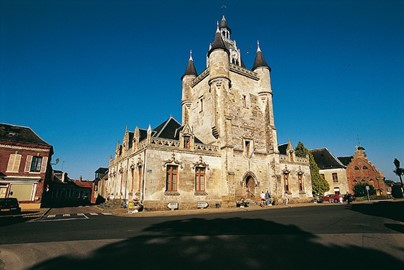search
León Viejo
The Ruins of León Viejo, a UNESCO World Heritage site in Nicaragua, offer a glimpse into one of the oldest Spanish colonial settlements in the Americas, founded in 1524 by Francisco Hernández de Córdoba. Abandoned in 1610 due to volcanic activity and earthquakes, this well-preserved archaeological site features remnants of homes, a cathedral, and a fortress, reflecting early colonial life. Excavations have revealed artifacts and human remains, providing insight into the daily lives and challenges of its inh... Read More
Land of Frankincense
Land of Frankincense, a UNESCO World Heritage site in Oman, encompasses ancient frankincense trade routes and archaeological remains that highlight the region's historical significance. It includes the ruins of medieval ports, such as Al-Baleed and Samhuram, which served as key hubs for exporting frankincense, a valuable resin prized in antiquity for its use in perfumes, incense, and medicine. The site also features the lush Wadi Dawkah, where frankincense trees still grow, illustrating the natural resource... Read More
Arequipa
The Historic Centre of Arequipa, a UNESCO World Heritage site in Peru, is renowned for its well-preserved colonial architecture, blending European and indigenous influences. Constructed primarily from white volcanic sillar stone, the city's buildings showcase ornate facades, arches, and courtyards, reflecting its rich history as a key Spanish settlement in the 16th century. Notable landmarks include the grand Basilica Cathedral and the Santa Catalina Monastery, a sprawling complex of colorful cloisters and ... Read More
Gyeongju
This UNESCO World Heritage site in South Korea encompasses a remarkable concentration of ancient temples, palaces, and royal tombs from the Silla Kingdom, which ruled from 57 BCE to 935 CE. Spanning multiple zones, it features well-preserved archaeological treasures like stone pagodas, Buddhist relics, and intricate rock carvings that showcase the kingdom’s architectural prowess and spiritual heritage. Visitors can explore sites that reflect a blend of natural beauty and historical significance, offering a ... Read More
Gochang, Hwasun and Ganghwa
The Gochang, Hwasun, and Ganghwa Dolmen Sites, recognized as a UNESCO World Heritage site in 2000, represent an exceptional collection of prehistoric megalithic tombs from the first millennium BCE. These sites showcase hundreds of dolmens—stone structures used as grave markers and for rituals—highlighting the advanced stonework and societal organization of the Bronze Age Megalithic Culture on the Korean Peninsula. With over 35,000 dolmens, Korea holds nearly 40% of the world’s total, and these locations pre... Read More
Kazan Kremlin
The Kazan Kremlin, a UNESCO World Heritage site in Russia, is a historic citadel showcasing a unique blend of Tatar and Russian architectural styles. Constructed primarily in the 16th century under Ivan the Terrible’s reign, it features notable structures like the Annunciation Cathedral and the leaning Söyembikä Tower, reflecting its rich cultural and political history. Originally a Tatar fortress, it was transformed into a Russian stronghold, symbolizing the region’s complex past. Today, it serves as a key... Read More
Ferapontov Monastery
Ferapontov Monastery, a UNESCO World Heritage site in Russia, is a well-preserved example of medieval Orthodox architecture and art. Founded in the late 14th century by Saint Ferapont, the monastery is renowned for its stunning frescoes, painted in 1502 by the master artist Dionisy, which adorn the interior of the Cathedral of the Nativity of the Virgin. These vibrant, detailed murals, along with the monastery’s serene white-stone structures, reflect Russia’s rich spiritual and cultural heritage, making it ... Read More
Island of Saint Louis
The Island of Saint-Louis, a UNESCO World Heritage site in Senegal, is a historic colonial settlement founded by French settlers in the 17th century. Renowned for its well-preserved architecture, the island showcases a blend of European and African influences, with charming pastel-colored buildings, narrow streets, and a distinctive grid layout. Once a bustling hub for trade and administration, it served as the capital of Senegal until 1957. Today, it stands as a cultural treasure, reflecting the region’s c... Read More
Bardejov
Bardejov, a UNESCO World Heritage site in Slovakia, is a remarkably well-preserved medieval town renowned for its historical and architectural significance. Its fortified walls, charming town square, and Gothic-style St. Egidius Basilica highlight its rich past as a thriving trade center along ancient European routes. The town also features one of the best-preserved Jewish quarters in Europe, including a synagogue and bathhouse, reflecting its cultural diversity. Bardejov stands as a testament to Slovakia’s... Read More
Tárraco
The Archaeological Ensemble of Tárraco, a UNESCO World Heritage site, showcases the ancient Roman city’s monumental remains, including a well-preserved amphitheater, circus, and a provincial forum. These structures reflect Tárraco’s significance as a political and cultural hub of the Roman Empire, featuring impressive engineering and architectural designs from the 2nd century BCE onward. The site also includes a Roman aqueduct and a necropolis, offering insights into Roman urban planning and daily life. Thi... Read More
Palmeral of Elche
The Palmeral of Elche, a UNESCO World Heritage site in Spain, is a remarkable historic landscape featuring an extensive grove of date palms. Established during the Islamic period between the 7th and 10th centuries, it showcases an intricate irrigation system that has sustained the palm groves for centuries, reflecting advanced agricultural practices of the time. This oasis-like setting also includes traditional huertos (garden plots) and is celebrated for its cultural and botanical significance, offering a ... Read More
Roman Walls of Lugo
The Roman Walls of Lugo, a UNESCO World Heritage site in Spain, are an exceptionally well-preserved example of Roman military architecture from the 3rd century AD. Constructed under Emperor Augustus, these fortifications stretch over 2 kilometers, featuring 85 semicircular towers and multiple gates, built with slate and granite. Originally designed to protect the Roman city of Lucus Augusti, the walls remain largely intact, offering a unique glimpse into ancient engineering and urban planning. Today, they s... Read More
Vall de Boí
Vall de Boí, a UNESCO World Heritage site in Spain, is renowned for its exceptional collection of Romanesque churches dating back to the 11th and 12th centuries. These well-preserved structures, including notable examples like Sant Climent de Taüll and Santa Maria de Taüll, showcase stunning architecture and intricate frescoes that reflect the region's medieval cultural and religious significance. The site’s historical importance and artistic value make it a remarkable testament to Catalonia’s Romanesque he... Read More
Atapuerca
The Archaeological Site of Atapuerca, a UNESCO World Heritage site in Spain, is renowned for its exceptional prehistoric findings, offering critical insights into early human evolution. Excavations have uncovered fossils and tools dating back over a million years, including remains of some of the earliest known hominins in Western Europe. The site's well-preserved evidence has significantly advanced scientific understanding of human ancestry and prehistoric life.
Central Suriname Nature Reserve
The Central Suriname Nature Reserve, a UNESCO World Heritage Site in Suriname, is a pristine tropical rainforest ecosystem formed in 1998 by merging three existing reserves with support from Conservation International and the government. Recognized in 2000 for its outstanding biodiversity, it safeguards a variety of habitats including montane and lowland forests, granite domes, and the upper watershed of the Coppename River. The reserve hosts over 5,000 plant species, 400 bird species like the Guiana Cock-o... Read More
Southern Oland
The Agricultural Landscape of Southern Öland, a UNESCO World Heritage site in Sweden, showcases a unique limestone plateau shaped by human activity for over 5,000 years. Its distinct features include ancient villages, arable fields, and grazing lands like the Stora Alvaret, reflecting a remarkable adaptation to the island's geology and climate. This living agrarian landscape preserves prehistoric settlements, medieval land divisions, and a rich biodiversity, offering a glimpse into a continuous cultural tra... Read More
Bellinzone
The Three Castles, Defensive Wall, and Ramparts of the Market-Town of Bellinzona form a UNESCO World Heritage site showcasing a remarkable medieval fortification system. This well-preserved ensemble includes three imposing castles—Castelgrande, Montebello, and Sasso Corbaro—linked by extensive defensive walls and ramparts. Designed to control strategic trade routes, the complex reflects a blend of architectural styles from the 13th to 15th centuries. Its historical significance and structural integrity make... Read More
St. George
The Historic Town of St George, a UNESCO World Heritage Site of UK in Bermuda, is renowned as one of the earliest English colonial towns, established in 1612. It features a well-preserved historic townscape with charming vernacular architecture and a network of fortifications that showcase the evolution of British military engineering from the 17th to 20th centuries. Recognized in 2000, this site highlights a unique blend of cultural and maritime heritage, reflecting its significance as a continuously inhab... Read More
Blaenavon Industrial Landscape
The Blaenavon Industrial Landscape, a UNESCO World Heritage Site in the UK, showcases the pivotal role of South Wales in the Industrial Revolution through its well-preserved 18th and 19th-century ironworks, coal mines, quarries, and transportation systems. Recognized in 2000, it features key sites like the Blaenavon Ironworks and Big Pit National Coal Museum, alongside workers’ housing and social infrastructure, illustrating the technological and societal advancements of early industrialization. This cultur... Read More
Zanzibar
The Stone Town of Zanzibar, a UNESCO World Heritage site, is a historic coastal trading hub renowned for its unique blend of African, Arab, Indian, and European architectural influences. This well-preserved urban settlement features a labyrinth of narrow streets lined with 19th-century stone houses, mosques, and palaces, reflecting its rich cultural heritage. Once a thriving center for the spice and slave trades, it remains a vibrant testament to its Swahili past, attracting visitors with its ornate wooden ... Read More
Shakhrisyabz
The Historic Centre of Shakhrisyabz, a UNESCO World Heritage site in Uzbekistan, is an ancient city along the Silk Road, renowned for its cultural and political significance during the 14th and 15th centuries under the Timurid Empire. It features exceptional monuments, including the grand ruins of the Ak-Saray Palace and the Kok-Gumbaz Mosque, showcasing Timurid architectural brilliance. As the birthplace of Amir Timur (Tamerlane), it reflects centuries of secular development, though it has been listed as a... Read More
Ciudad Universitaria de Caracas
Ciudad Universitaria de Caracas, a UNESCO World Heritage site in Venezuela, is a remarkable example of modernist architecture designed by Carlos Raúl Villanueva. Completed between the 1940s and 1960s, it serves as the main campus of the Central University of Venezuela, blending functional buildings with open plazas, lush gardens, and striking artworks. Its innovative design and cultural significance earned it global recognition as a masterpiece of urban planning and architectural creativity.
Belfries of Belgium and France
The Belfries of Belgium and France, a UNESCO World Heritage site recognized in 1999 and expanded in 2005, are 56 medieval civic towers across Belgium and northern France, built between the 11th and 17th centuries. Symbolizing urban autonomy and power, these belfries, often part of town halls or cloth halls, feature intricate Gothic and Renaissance designs with bells for signaling time and events. This transnational site reflects the region’s rich civic heritage, showcasing architectural innovation and the r... Read More
Cueva de las Manos
Cueva de las Manos, a UNESCO World Heritage site in Argentina, recognized in 1999, is a prehistoric rock art site in Patagonia featuring cave paintings from 13,000 to 9,500 years ago. Its vivid hand stencils, hunting scenes, and animal depictions, etched in vibrant colors along a canyon wall, reflect the artistry of early hunter-gatherers. This site showcases Argentina’s ancient heritage, preserving a stunning record of human creativity in a remote landscape.
Península Valdés
Península Valdés, a UNESCO World Heritage site in Argentina, recognized in 1999, is a coastal reserve along the Atlantic renowned for its exceptional marine biodiversity. Home to breeding grounds for southern right whales, sea lions, and Magellanic penguins, its rugged shores and steppe landscape reflect a critical wildlife haven. This site showcases Argentina’s natural heritage, offering a vital sanctuary for marine species in a pristine Patagonian setting.
























